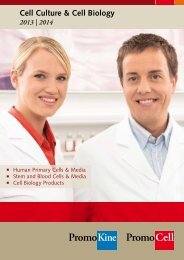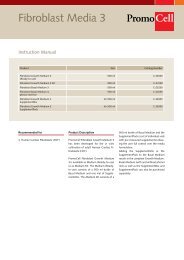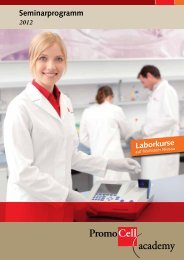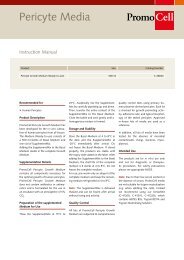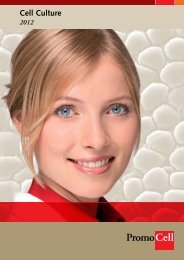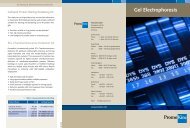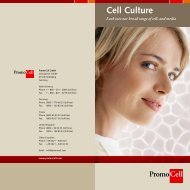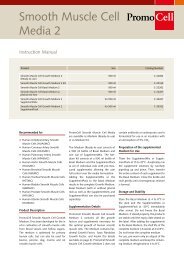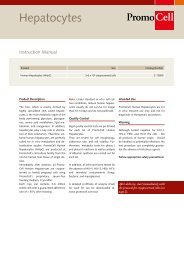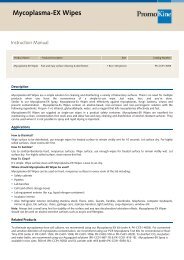PCR Bacteria Test Kit - PromoCell
PCR Bacteria Test Kit - PromoCell
PCR Bacteria Test Kit - PromoCell
You also want an ePaper? Increase the reach of your titles
YUMPU automatically turns print PDFs into web optimized ePapers that Google loves.
<strong>PCR</strong> <strong>Bacteria</strong> <strong>Test</strong> <strong>Kit</strong><br />
Instruction Manual
2 Instruction Manual<br />
Instruction Manual<br />
3<br />
Contents<br />
Reagents and Materials 3<br />
Application and <strong>Test</strong> Principle 4<br />
Precautions 5<br />
<strong>Test</strong> Protocol 5<br />
Appendix 11<br />
Ordering Information 12<br />
Reagents and Materials<br />
<strong>Kit</strong> Components<br />
<strong>Bacteria</strong> Mix red cap; lyophilized<br />
Containing primer set, deoxynucleotide triphosphates dATP, dCTP,<br />
dGTP and dUTP, hot-start Taq polymerase and internal amplification<br />
control; aliquoted for 25 reactions, lyophilized; 1 vial (PK-CA91-2024)<br />
or 2 vials (PK-CA91-2048)<br />
Rehydration Buffer blue cap; 1.3 ml<br />
Positive Control DNA green cap<br />
DNA-fragment of Bacillus subtilis genome, prepared by <strong>PCR</strong>, noninfectious,<br />
lyophilized; 1 vial<br />
<strong>PCR</strong>-grade water white cap; 2 ml<br />
Instruction Manual<br />
Stability and Storage<br />
<strong>Kit</strong> components are stable during shipping. Upon receipt, store at +2<br />
to +8°C. After rehydration of the <strong>Bacteria</strong> Mix and the Positive<br />
Control DNA, store below –18°C and avoid repeated freezing and<br />
thawing. For repeated testing of low sample numbers <strong>Bacteria</strong> Mix<br />
and Positive Control DNA should be aliquoted after rehydration. By<br />
following these recommendations, the kit is stable until the expiration<br />
date stated on the label.<br />
Supplemental Requirements<br />
• <strong>PCR</strong> thermal cycler<br />
• mineral oil, if required for the particular thermal cycler used<br />
• <strong>PCR</strong> reaction tubes for the specific <strong>PCR</strong> device<br />
• 1.5 ml reaction tubes (DNA and RNA-free)<br />
• agarose gel electrophoresis apparatus<br />
• microcentrifuge for 1.5 ml reaction tubes, micropipettes (10, 100<br />
and 1000 μl) and filter tips
4 Instruction Manual<br />
Instruction Manual<br />
5<br />
Application and <strong>Test</strong> Principle<br />
This kit utilizes the polymerase chain reaction (<strong>PCR</strong>), thereby<br />
providing the highest sensitivity for the detection of bacterial<br />
contamination in cell cultures and other cell culture derived<br />
biologicals. Detection requires as little as 52 fg of bacterial DNA<br />
corresponding to 12 bacterial genomes per sample volume. The<br />
primer set is specific to a highly conserved portion of the 16S rRNA<br />
coding region in the bacterial genome. The amplified <strong>PCR</strong> products<br />
have a size of 466-468 bp (except Micrococcus luteus with 447 bp)<br />
and can be analyzed by agarose gel electrophoresis. This allows for<br />
detection of common airborne contaminants in cell cultures including:<br />
Pseudomonas, Actinomyces, Escherichia, Serratia, Porphyromonas,<br />
Fusobacteria, Staphylococcus, Streptococcus, Lactobacillus,<br />
Micrococcus, Bacillus, Klebsiella, Salmonella, Enterococcus,<br />
Mycobacterium, Legionella, Prevotella, Peptostreptococcus.<br />
Eukaryotic DNA is not amplified using this kit. Only one protocol is<br />
needed for the detection of bacteria and can be performed within 3<br />
hours.<br />
The kit also provides internal control DNA already included in the<br />
<strong>Bacteria</strong> Mix. When running the <strong>PCR</strong> with the internal control DNA, a<br />
successful <strong>PCR</strong> is indicated by a 210 bp band on the agarose gel.<br />
The lyophilized <strong>Bacteria</strong> Mix also includes hot-start Taq polymerase as<br />
well as dATP, dCTP, dGTP and dUTP (instead of dTTP; this provides<br />
the option to degrade amplicons from previous analyses using uracil-<br />
DNA glycosylase [UNG]* in order to minimize false-positive results).<br />
* UNG is not part of the kit.<br />
This kit is intended for research use only. Not for clinical diagnostics<br />
or testing of human samples.<br />
Precautions<br />
Cross contamination may lead to false-positive results. The test should<br />
be performed according to good laboratory practice:<br />
• Clean work surface with plenty of water<br />
• Always wear gloves<br />
• Use freshly laundered overalls and protective sleeves<br />
• Use a facemask and avoid talking during <strong>PCR</strong> setup<br />
• Always use new boxes of certified, DNA-free “<strong>PCR</strong>-clean”<br />
consumables (tubes, filter tips)<br />
• Do not autoclave <strong>PCR</strong> consumables (tubes, filter tips) in<br />
autoclaves that are also used for autoclaving waste<br />
• Clean pipettes regularly with plenty of water or DNA-removing<br />
cleansers<br />
• Do not work at work benches with recirculated air (laminar flow)<br />
or badly maintained filters and avoid drafts (e.g., passing<br />
colleagues) during pipetting<br />
<strong>Test</strong> Protocol<br />
Preparation of Sample Material<br />
1. Antibiotics can maintain the bacterial contamination at a level<br />
beneath the detection limit of the test (2.4 x 10 3 bacteria/ml).<br />
Therefore, prior to testing, the cells should be pre-cultured in the<br />
absence of antibiotics for at least one passage.<br />
2. DNA extraction with a commercially available DNA extraction kit<br />
is always advisable when preparing the samples in order to<br />
remove inhibitors of the <strong>PCR</strong> safely and to lyse bacteria<br />
completely. The obtained DNA extract can be used directly for<br />
the test avoiding inhibition.<br />
3. The sample should not contain more than 300 μg/ml DNA.<br />
4. DNA extracts and heat-inactivated samples can be kept at 2-8°C<br />
for less than a week and stored at a temperature of at least<br />
–18°C for a longer period (~1 year; avoid repeated freezing and<br />
thawing!).
6 Instruction Manual<br />
Instruction Manual<br />
7<br />
5. The sample should not contain more than 300 μg/ml DNA.<br />
6. To avoid false positive results, we strongly recommend the use of<br />
deionized, DNA-free water, aerosol-preventive filter tips and<br />
gloves.<br />
Rehydration of the Reagents<br />
1. Centrifuge tubes with lyophilized components (5 seconds at<br />
maximum speed of the microcentrifuge)<br />
2. <strong>Bacteria</strong> Mix: Add 520 μl of Rehydration Buffer (blue cap) and<br />
incubate for 5 minutes at room temperature. Then, vortex briefly<br />
and spin for 5 seconds<br />
3. Positive Control DNA: Add 300 μl of <strong>PCR</strong>-grade water (white<br />
cap) and incubate for 5 minutes at room temperature. Then,<br />
vortex briefly and spin for 5 seconds<br />
Keep reagents on ice and store below -18°C after rehydration. Avoid<br />
repeated freeze-thaw cycles and store reconstituted Positive Control<br />
DNA in aliquots.<br />
1. <strong>Bacteria</strong> Mix, red cap<br />
Positive Control DNA, green cap<br />
Spin all freeze-dried components for 5 seconds<br />
at maximum speed of the centrifuge<br />
2. <strong>Bacteria</strong> Mix, red cap Add 520 μl Rehydration BUffer (blue cap)<br />
3. Positive Control DNA, green cap Add 300 μl <strong>PCR</strong> grade Water (white cap)<br />
4. <strong>Bacteria</strong> Mix, red cap<br />
Positive Control DNA, green cap<br />
5. <strong>Bacteria</strong> Mix, red cap<br />
Positive Control DNA, green cap<br />
Incubate 5 minutes at room temperature<br />
Vortex DNA briefly and spin for 5 seconds<br />
<strong>Test</strong> should be performed with negative and positive controls and<br />
samples in duplicate. All samples and reagents must be equilibrated to<br />
2-8°C prior to use.<br />
Loading the test tubes<br />
Total volume per reaction is 25 μl. When setting up reactions,<br />
calculations should also include positive and negative controls.<br />
Aliquot 20 μl of <strong>Bacteria</strong> Mix into each <strong>PCR</strong> reaction tube.<br />
Negative Control: Add 5 μl of <strong>PCR</strong>-grade water (white cap) to <strong>PCR</strong><br />
reaction tube with 20 μl of <strong>Bacteria</strong> Mix as negative control.<br />
Samples: Add 5 μl of sample (cell culture supernatant or DNA extract)<br />
to <strong>PCR</strong> reaction tube with 20 μl of <strong>Bacteria</strong> Mix<br />
Positive Control: Add 5 μl of Positive Control DNA (green cap) to<br />
<strong>PCR</strong> reaction tube with 20 μl of <strong>Bacteria</strong> Mix<br />
Close all <strong>PCR</strong> tubes and spin briefly. Load <strong>PCR</strong> cycler and start cycler<br />
program.<br />
Note: The pipetting sequence should be respected and the tubes<br />
closed after each sample load. After pipetting the negative control,<br />
the tube must be sealed before proceeding with the samples.<br />
Pipetting of the samples and sealing the tubes must also be completed<br />
before proceeding with the positive control (green cap) in order to<br />
avoid cross contamination.<br />
1. Aliquot 20 μl of <strong>Bacteria</strong> Mix to each <strong>PCR</strong> tube.<br />
2. Negative Controls: add 5 μl <strong>PCR</strong> grade Water or elution buffer from DNA<br />
extraction kit (ref. chapter “Specimen“) or (white cap).<br />
3. Samples: add 5 μl of cell culture supernatant or DNA extract.<br />
4. Positive Control: add 5 μl Positive Control DNA (green cap).<br />
5. Close and spin all <strong>PCR</strong> tubes briefly, load the <strong>PCR</strong> cycler and start the program.
8 Instruction Manual<br />
Instruction Manual<br />
9<br />
Thermal Profile<br />
Load the cycler, check each <strong>PCR</strong> tube and the cycler lid for tight fit.<br />
Program the <strong>PCR</strong> cycler or check stored temperature profile. The<br />
programming process of your cycler is explained in the manual of the<br />
instrument.<br />
Program:<br />
• 1 cycle<br />
• 94°C for 2 minutes<br />
• 35 cycles<br />
• 94°C for 30 seconds<br />
• 55°C for 30 seconds<br />
• 72°C for 30 seconds<br />
• cool down to 4°C to 8°C<br />
Agarose Gel Run<br />
• 1.5% standard agarose gel, maximal 5 mm thick, with 5 mmcomb<br />
• load 5 μl of each <strong>PCR</strong> reaction, mixed with bromophenol blue<br />
loading buffer per lane (only bromophenol blue in a low<br />
concentration should be used as a run marker)<br />
• stop electrophoresis after 2-3 cm run distance (depending on the<br />
electrophoresis chamber used, e.g. run for 20-30 minutes at<br />
100 V)<br />
caused by bacterial DNA loads of >5x10 6 copies/ml. The initial<br />
concentration of positive control DNA exceeds 5 x 10 6 copies/ml in<br />
order to account for DNA loss resulting from repeated freezing and<br />
thawing. Consequently, the internal control is usually not visible in the<br />
positive control reaction.<br />
Relevant amplicon sizes:<br />
Internal control: 210 bp<br />
<strong>Bacteria</strong>: 466-468 bp<br />
Micrococcus luteus: 447 bp<br />
Results of a successfully performed <strong>PCR</strong>:<br />
negative control: band at 210 bp<br />
positive control/sample: band at 468 bp, possibly additional band<br />
at 210 bp<br />
negative sample<br />
inhibited sample<br />
positive sample, weak contamination<br />
positive sample, strong contamination<br />
negative control with internal control<br />
1 kb DNA ladder<br />
Gel Evaluation<br />
If internal control DNA was used, a distinct 210 bp band should<br />
appear in every lane indicating a successfully performed <strong>PCR</strong>. This<br />
band may fade out with increased amounts of amplicons formed,<br />
No amplification of Positive Control DNA may be due to the following<br />
reasons:<br />
• control DNA tubes have not been spun down before rehydration<br />
• programming mistake<br />
• pipetting mistake
10 Instruction Manual<br />
Instruction Manual<br />
11<br />
Before rerun of a negative and a positive control please check<br />
thermocycler protocol and pipetting scheme. Interpretation of possible<br />
band patterns:<br />
band at 210 bp:<br />
band at approx. 467 bp and at 210 bp:<br />
strong band at approx. 467 bp:<br />
no band:<br />
Detection of bacteria<br />
band at approx. 467 bp<br />
Internal control<br />
band at 210 bp<br />
negative sample<br />
bacteria-positive sample,<br />
weak contamination<br />
bacteria-positive sample,<br />
highly contaminated<br />
<strong>PCR</strong> inhibition<br />
Interpretation<br />
positive irrelevant bacteria present in the sample<br />
negative negative <strong>PCR</strong> inhibition<br />
negative positive no bacteria detectable in the sample<br />
2. The reagents supplied should not be mixed with reagents from<br />
different lots and used as an integral unit.<br />
3. The reagents of the kit should not be used beyond its shelf life.<br />
4. For each test setup, at least one negative control should be<br />
included, possibly reflecting sample preparation. Positive controls<br />
facilitate the evaluation of the test.<br />
5. Inhibition may be caused by the sample matrix, but also by<br />
sample elution buffer of DNA extraction kits not recommended or<br />
validated. Negative controls should always be completed with the<br />
use of sample elution buffer.<br />
6. The use of control samples is advised to secure the day-to-day<br />
validity of results. The controls should be carried out in the same<br />
manner as the samples. It is recommended to run laboratory<br />
specific control samples with a high, medial and low (e.g. 3x<br />
LOD95) level. Participation in external quality control programs is<br />
recommended.<br />
NOTES ON THE TEST PROCEDURE<br />
Rarely unspecific <strong>PCR</strong> products can be formed and become visible in<br />
the gel as faint, diffuse bands of different sizes (not 210 or 467 bp),<br />
but do not indicate positive results. These faint, diffuse bands are<br />
mainly caused by non-specific annealing due to overloading of the<br />
<strong>PCR</strong> reaction with samples containing more than 300 μg/ml of DNA.<br />
However, these unspecific <strong>PCR</strong> products do not indicate positive<br />
results.<br />
Possible primer self-annealing produces another band of 80-90 bp in<br />
length, but also does not affect the precision or results of the test.<br />
If the <strong>PCR</strong> of a sample is inhibited (lower band intensity compared to<br />
negative control), <strong>PCR</strong> inhibitors can easily be removed from the<br />
sample by performing a DNA extraction with a commercially available<br />
kit and testing the sample again.<br />
1. Read this handbook carefully and follow the recommended<br />
procedure. Any deviation from the test method can affect the<br />
results.<br />
Appendix<br />
Limited Product Warranty<br />
This warranty limits our liability for replacement of this product. No<br />
warranties of any kind, express or implied, including, without<br />
limitation, implied warranties of merchantability or fitness for a<br />
particular purpose, are provided. <strong>PromoCell</strong> shall have no liability for<br />
any direct, indirect, consequential, or incidental damages arising out<br />
of the use, the results of use, or the inability to use this product.<br />
Notice to Purchaser<br />
This product is optimized for use in the Polymerase Chain Reaction<br />
(„<strong>PCR</strong>”) covered by patents owned by Hoffmann-La Roche, Inc., and<br />
F. Hoffmann-La Roche Ltd. („Roche”). No license under these patents<br />
to use the <strong>PCR</strong> process is conveyed expressly or by implication to the<br />
purchaser of this product. <strong>PromoCell</strong> does not encourage or support<br />
the unauthorized or unlicensed use of the <strong>PCR</strong> process. Use of this<br />
product is restricted to persons that either have a license to perform<br />
<strong>PCR</strong> or are not required to obtain a license.
12 Instruction Manual<br />
Instruction Manual<br />
13<br />
Ordering Information<br />
Product Name Size Catalog Number<br />
<strong>PCR</strong> <strong>Bacteria</strong> <strong>Test</strong> <strong>Kit</strong> 24 assays PK-CA91-2024<br />
<strong>PCR</strong> <strong>Bacteria</strong> <strong>Test</strong> <strong>Kit</strong> 48 assays PK-CA91-2048<br />
For in vitro research use only.<br />
Not for diagnostic or therapeutic procedures.<br />
<strong>PromoCell</strong> GmbH<br />
Sickingenstr. 63/65<br />
69126 Heidelberg<br />
Germany<br />
North America<br />
Phone: 1 – 866 – 251 – 2860 (toll free)<br />
Fax: 1 – 866 – 827 – 9219 (toll free)<br />
Deutschland<br />
Telefon: 0800 – 776 66 23 (gebührenfrei)<br />
Fax: 0800 – 100 83 06 (gebührenfrei)<br />
France<br />
Téléphone: 0800 90 93 32 (ligne verte)<br />
Téléfax: 0800 90 27 36 (ligne verte)<br />
United Kingdom<br />
Phone: 0800 – 96 03 33 (toll free)<br />
Fax: 0800 – 169 85 54 (toll free)<br />
Other Countries<br />
Phone: +49 6221 – 649 34 0<br />
Fax: +49 6221 – 649 34 40<br />
Email: info@promokine.info<br />
05/2013



